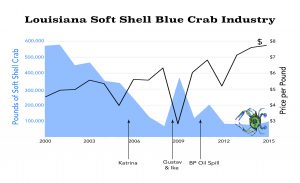A Declining Delicacy
Soft-shell blue crabs, on average, sell for seven times more than their hard-shell counterparts. Yet, soft-shell production in Louisiana has dropped from a high of 2.37 million pounds in 1945 to a meager 9,522 pounds in 2015. Why?
That’s a mystery that researchers at Louisiana Sea Grant (LSG), the University of Maryland and the Virginia Institute of Marine Science are trying to solve.
“The last look at Louisiana’s industry took place in 1991 through surveys conducted by Sea Grant,” said Julie Lively, LSG and LSU AgCenter fisheries specialist. “At that time, there were about 300 soft-shell producers – most being small, family-owned operations. Today, we think there may be fewer than 50 soft-shell producers.”
In order to have market-ready soft-shells, crabbers put peelers – crabs that are close to shedding – into holding tanks. The peelers are held in the tanks until they swell and split their hard-shell in the back, through which they squeeze. The freshly molted crab must then be removed from the water quickly, before its new exoskeleton hardens. Consequently, the crabs need to be monitored closely.
Could producers simply be exiting the industry because it is too labor intensive? Or is over-regulation, pollution, competition from other states, mortality caused by disease or other factors why Louisiana’s soft-shell production is a shadow of its former self?
“A lack of communication between the soft-shell industry and the scientific community has left a lot of unanswered questions about the continued decline of such a high-value product,” said Lively. “One possible source of the decline may be a high mortality rate in shedding systems due to diseases such as Reo-Like Virus (RLV).”
Along the Atlantic Coast, RLV has been found in the majority of crabs that die in soft-shell systems. It may be present in 10 percent or more of Louisiana crabs. RLV is transmissible through sharing the same water with infected peelers or through cannibalism – which is common among blue crabs.
“One of our research objectives is to understand why high mortality rates exist in shedding systems with the goal of helping shedders remain in business,” said Lively.
A first step in the study will be to survey current Louisiana soft-shell producers and find out what they are experiencing. Producers interested in helping provide some answers can contact Lively at [email protected] or at (225) 578-0771.
“The ultimate goal is to provide fishermen with information on which to base decisions to preserve the blue crab resource and increase their profits,” said Lively.

